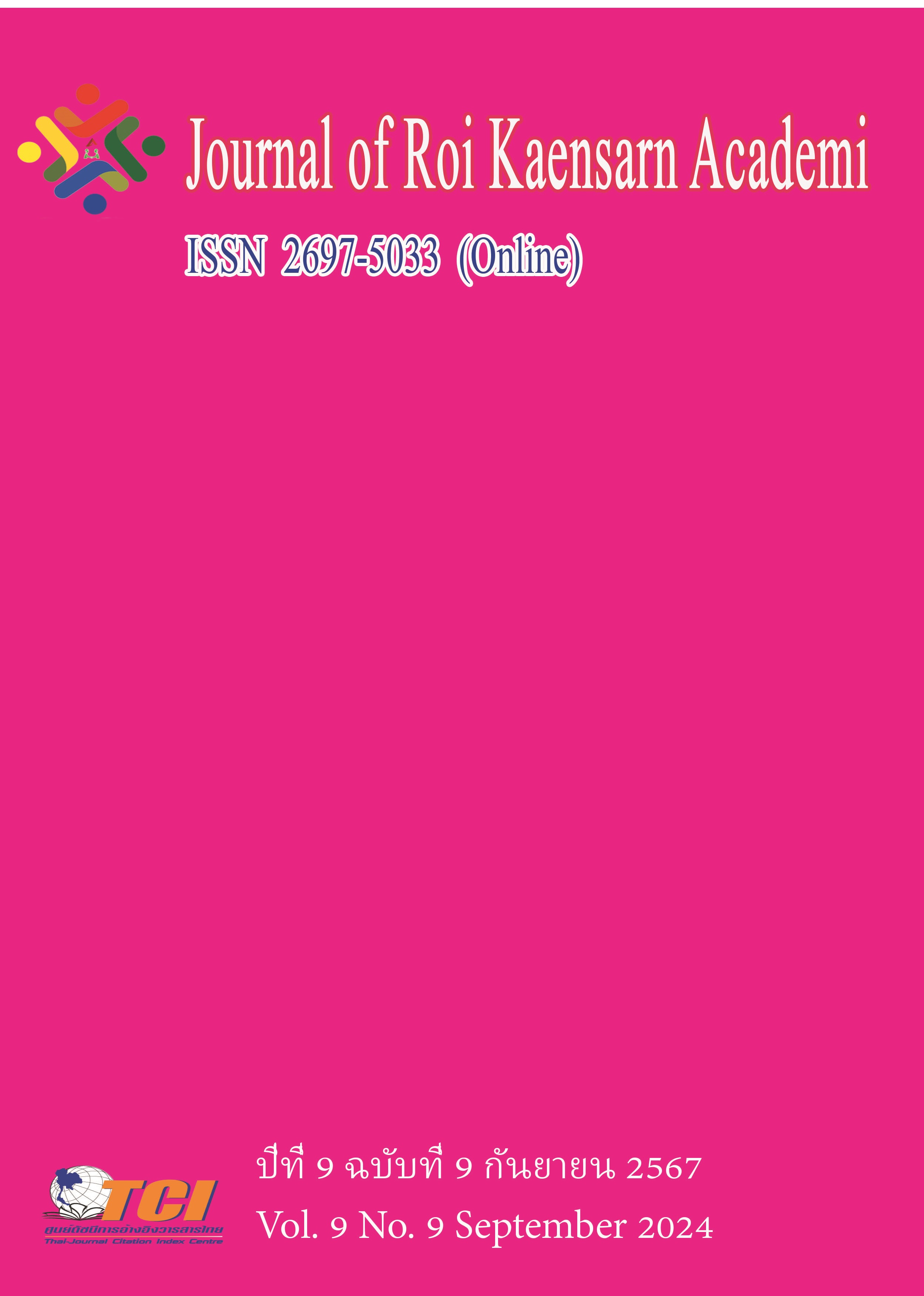The Competitive Advantage Model of China’s “Double First-Class” University Libraries from Knowledge-Based Dynamic Capabilities
Main Article Content
บทคัดย่อ
This research aims to explore the competitive advantage model of China’s“Double First-Class” university libraries through the lens of knowledge-based dynamic capabilities, with service innovation as a mediating factor. The study employs a mixed research method. A quantitative approach involved collecting 420 valid questionnaires from these university libraries, with data analyzed using SPSS and AMOS to construct a structural equation model. Additionally, qualitative research was conducted through in-depth interviews with 9 key informants, including department directors and deputy directors from these libraries. These interviews provided valuable insights into how knowledge-based dynamic capabilities can enhance the competitive advantage of university libraries and supported the quantitative data analysis. The research results indicate that knowledge-based dynamic capabilities significantly influence the competitive advantage model of university libraries via service innovation. The main contribution of this study is the development of a reference competitive advantage model for university libraries, aimed at better enhancing their competitive position.
Article Details
เอกสารอ้างอิง
Adama, H. E., Popoola, O. A., Okeke, C. D., & Akinoso, A. E. (2024). Theoretical frameworks supporting IT and business strategy alignment for sustained competitive advantage. International Journal of Management & Entrepreneurship Research, 6 (4), 1273-1287. https://doi.org/10.51594/ijmer.v6i4.1058
Beuter Júnior, N., Faccin, K., Volkmer Martins, B., & Balestrin, A. (2019). Knowledge-based dynamic capabilities for sustainable innovation: the case of the green plastic project. Sustainability, 11 (8), 2392. https://doi.org/10.3390/su11082392
Chen, B., Chen, Y., Sun, Y., Tong, Y., & Liu, L. (2024). The measurement, level, and influence of resource allocation efficiency in universities: empirical evidence from 13 “double first class” universities in China. Humanities and Social Sciences Communications, 11 (1), 1-16. https://doi.org/10.1057/s41599-024-03461-z
Chen, X., Xie, H., & Zhou, H. (2024). Incremental versus Radical Innovation and Sustainable Competitive Advantage: A Moderated Mediation Model. Sustainability, 16 (11), 4545. https://doi.org/10.3390/su16114545
Denford, J. S. (2013). Building knowledge: developing a knowledge‐based dynamic capabilities typology. Journal of Knowledge Management, 17 (2), 175-194. https://doi.org/10.1108/13673271311315150
Deqiang, Q. (2022). A study on the basic characteristics of the selection of headmasters of provincial "double first-class" universities in China. International Journal of New Developments in Education, 4(11), 96-101. https://doi.org/10.25236/ IJNDE. 2022.041120.
Drempetic, S., Klein, C., & Zwergel, B. (2020). The influence of firm size on the ESG score: Corporate sustainability ratings under review. Journal of business ethics, 167 (2), 333-360.
Edgar, W. B. (2022). The University Library’s Strategic Process: Competing Through Plans, Positions, and Resources. Libri, 72 (3), 199-217. https://doi.org/10.1515/libri-2021-0150
Education, C. M. o. (2015). Promoting overall construction of world-class universities and first-class disciplines. http://www.moe.gov.cn/jyb_xxgk/moe_1777/moe_1778/ 201511/t20151105_217823.html
Faccin, K., Balestrin, A., Volkmer Martins, B., & Bitencourt, C. C. (2019). Knowledge-based dynamic capabilities: a joint R&D project in the French semiconductor industry. Journal of Knowledge Management, 23 (3), 439-465. https://doi.org/10.1108/JKM-04-2018-0233
Goddard, M. (2020). The impact of knowledge management on innovation in academic libraries. Pathfinder: A Canadian Journal for Information Science Students and Early Career Professionals, 1 (2), 72-81. https://doi.org/10.29173/pathfinder9
Han, Y. (2019). The relationship between ambidextrous knowledge sharing and innovation within industrial clusters: Evidence from China. Interdisciplinary Journal of Information, Knowledge, and Management, 14, 145. https://doi.org/10.28945/4299
Ismail, I. J. (2024). The predicting role of knowledge-based dynamic capabilities on innovation performance of small enterprises in Tanzania: mediating effect of innovation culture. Technological Sustainability, 3 (2), 195-211. https://doi.org/10. 1108/TECHS-03-2023-0014
Kindström, D., Kowalkowski, C., & Sandberg, E. (2013). Enabling service innovation: A dynamic capabilities approach. Journal of Business Research, 66 (8), 1063-1073. https://doi.org/10.1016/j.jbusres.2012.03.003
Li, X., Wu, T., Zhang, H.-J., & Yang, D.-Y. (2023). National innovation systems and the achievement of sustainable development goals: Effect of knowledge-based dynamic capability. Journal of Innovation & Knowledge, 8 (1), 100310. https://doi.org/10.1016/j.jik.2023.100310
Lin, Y.-H., & Chen, Y.-S. (2017). Determinants of green competitive advantage: the roles of green knowledge sharing, green dynamic capabilities, and green service innovation. Quality & Quantity, 51, 1663-1685. https://doi.org/10.1007/s11135-016-0358-6
Migdadi, M. M. (2022). Knowledge management processes, innovation capability and organizational performance. International Journal of Productivity and Performance Management, 71 (1), 182-210. https://doi.org/10.1108/IJPPM-04-2020-0154
Nayak, B., Bhattacharyya, S. S., & Krishnamoorthy, B. (2023). Integrating the dialectic perspectives of resource-based view and industrial organization theory for competitive advantage–a review and research agenda. Journal of Business & Industrial Marketing, 38 (3), 656-679.
Robinson, J. (2024). Likert scale. In Encyclopedia of quality of life and well-being research (pp. 3917-3918). Springer.
Shan, S., Luo, Y., Zhou, Y., & Wei, Y. (2019). Big data analysis adaptation and enterprises’ competitive advantages: the perspective of dynamic capability and resource-based theories. Technology Analysis & Strategic Management, 31 (4), 406-420. https://doi.org/10.1080/09537325.2018.1516866
Suifan, T., Alhyari, S., & Qandah, R. (2021). Role of Knowledge Infrastructure Capabilities in Product/Service Innovation. Journal of Information & Knowledge Management, 20 (02), 2150023. https://doi.org/10.1142/s0219649221500234
Teece, D. J., Pisano, G., & Shuen, A. (1997). Dynamic capabilities and strategic management. Strategic management journal, 18 (7), 509-533.
Xuan-Nhi, N., & Ngoc-Tien, L. (2023). Green CSR's role in retail competitive advantage: mediation by marketing and moderation by reputation. Journal for Global Business Advancement, 16 (2), 285-312. https://doi.org/10.1504/JGBA.2023.138498
Yang, J., Hu, D., Liu, Q., Wang, L., & Li, B. (2019). Exploring the multi-level development direction of Chinese universities under the background of ' double first-class '. Education and Teaching Forum. (3), 3. https://doi.org/10.3969/j.issn.1674-9324.2019.03.005
Zhang, Y. (2008). User Knowledge Management and Competitive Advantages of University Libraries. Intelligence Work (6), 84-85.
Zhang, Y. (2017). Construction of first-class teaching staff under the background of "double first-class": progress, difficulties and breakthroughs——Taking Guangdong Vocational and Technical College of Posts and Telecommunications as an example. University (Research Edition). (6), 68-73.
Zotoo, I. K., Lu, Z., & Liu, G. (2021). Big data management capabilities and librarians' innovative performance: The role of value perception using the theory of knowledge-based dynamic capability. The Journal of Academic Librarianship, 47 (2), 102272. https://doi.org/10.1016/j.acalib.2020.102272

